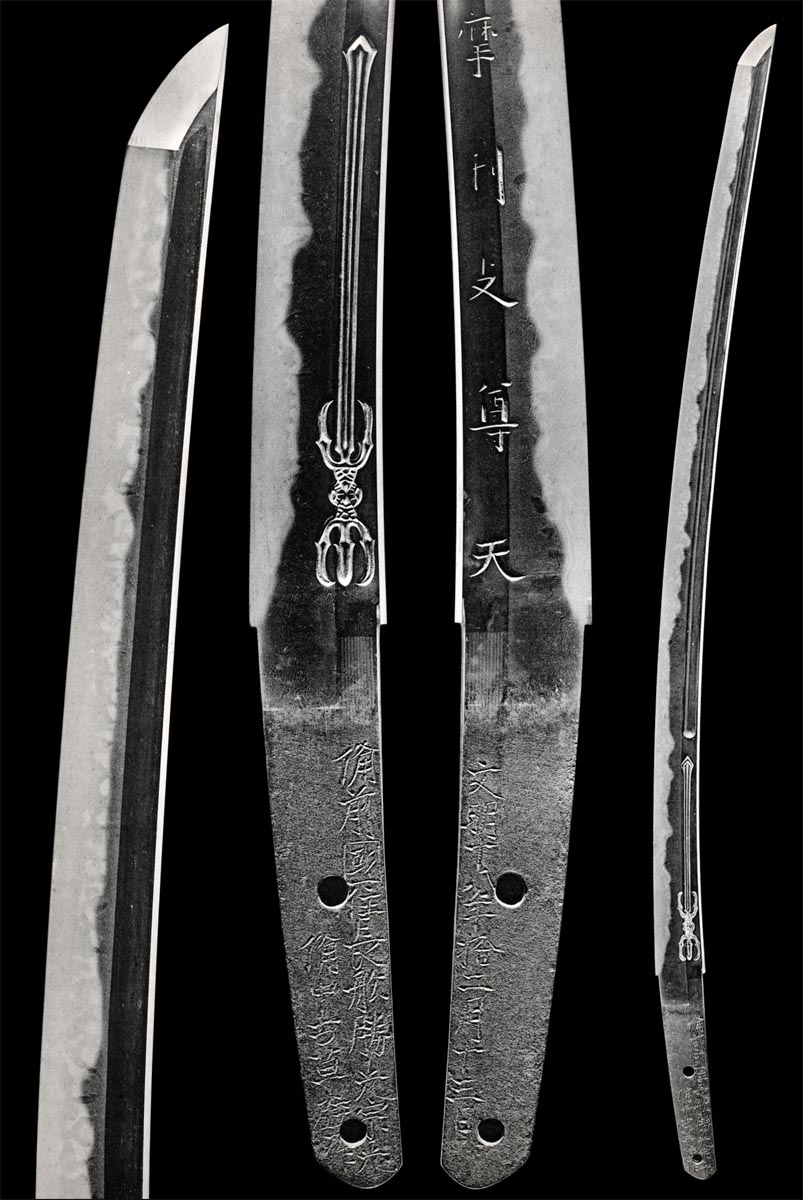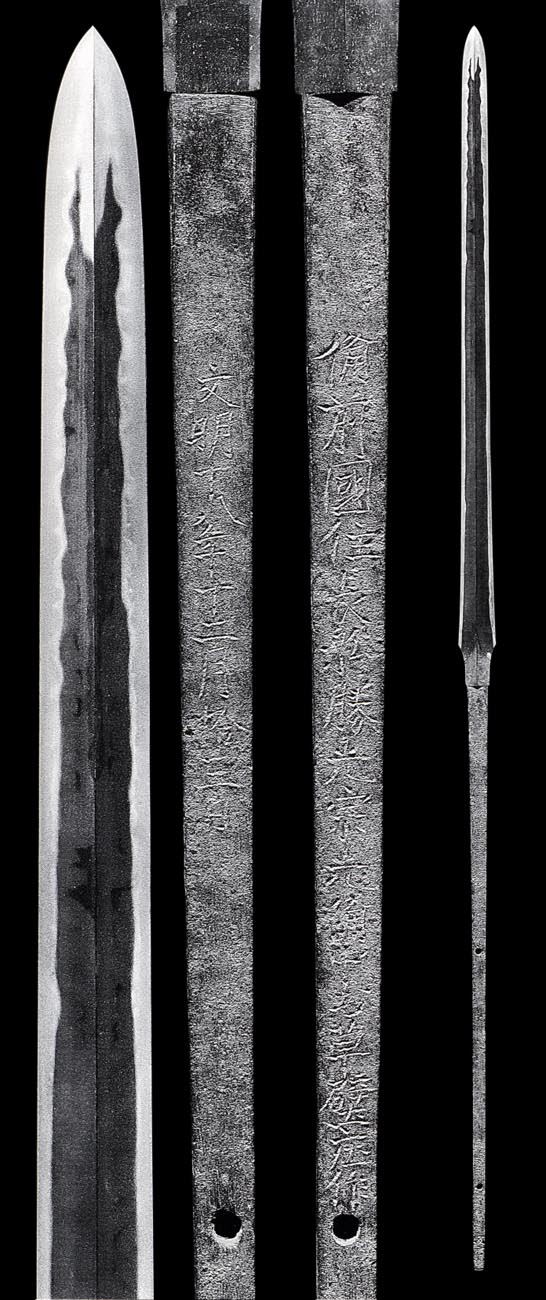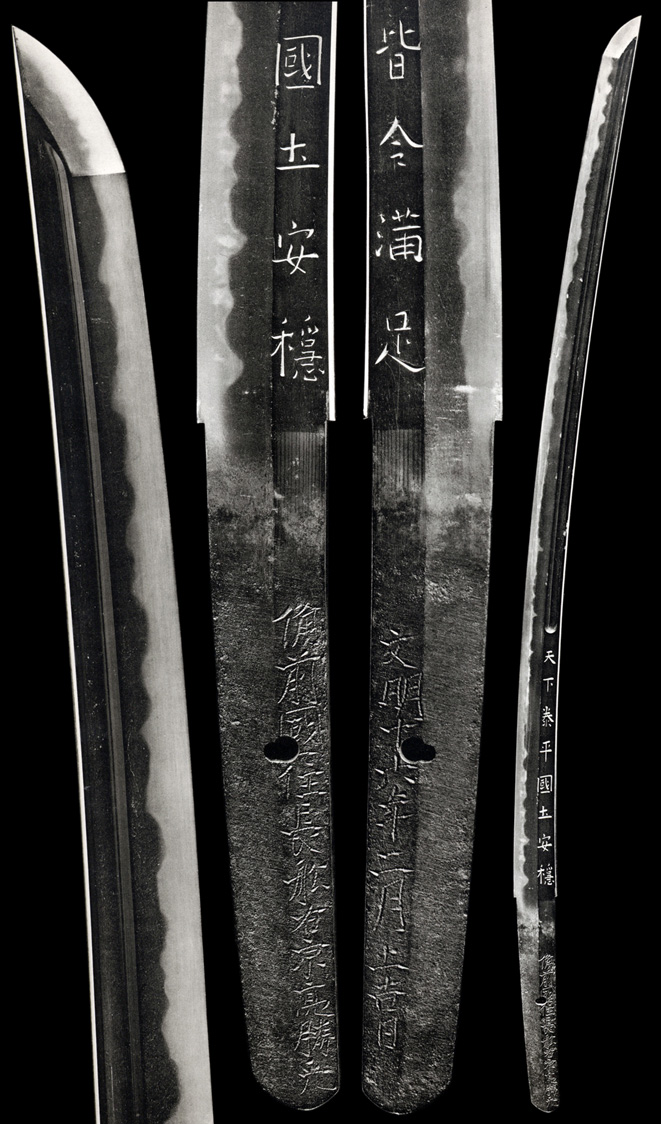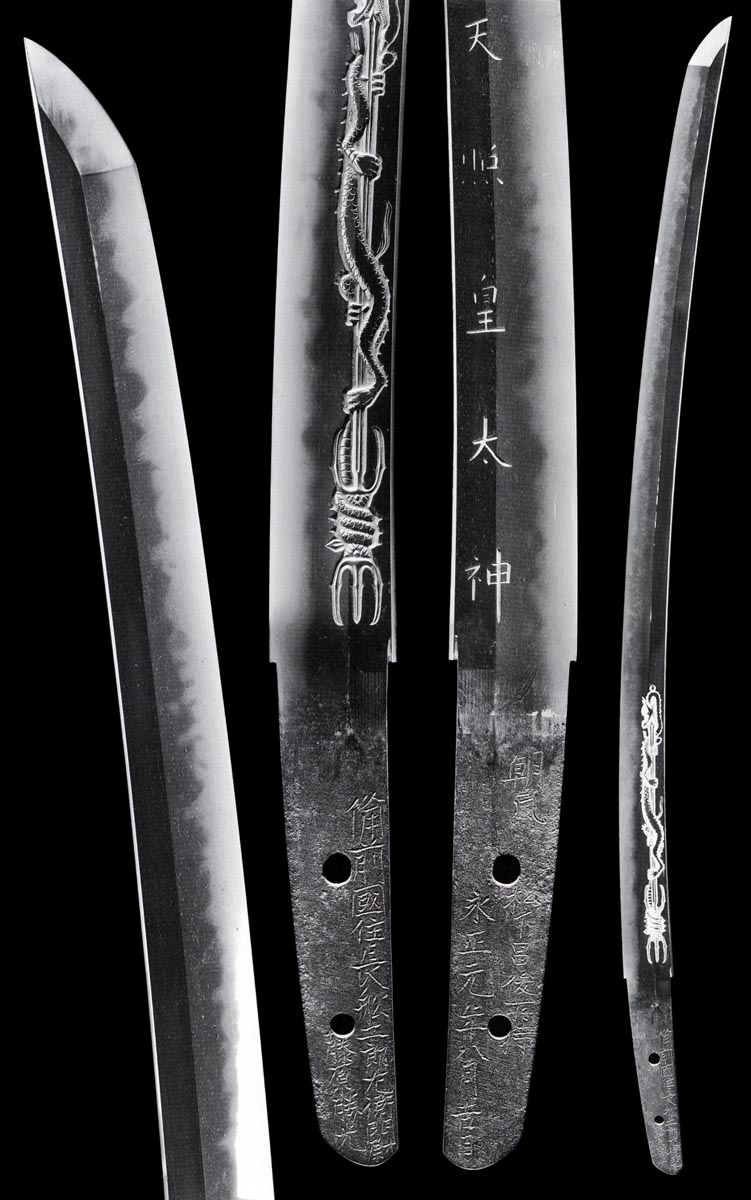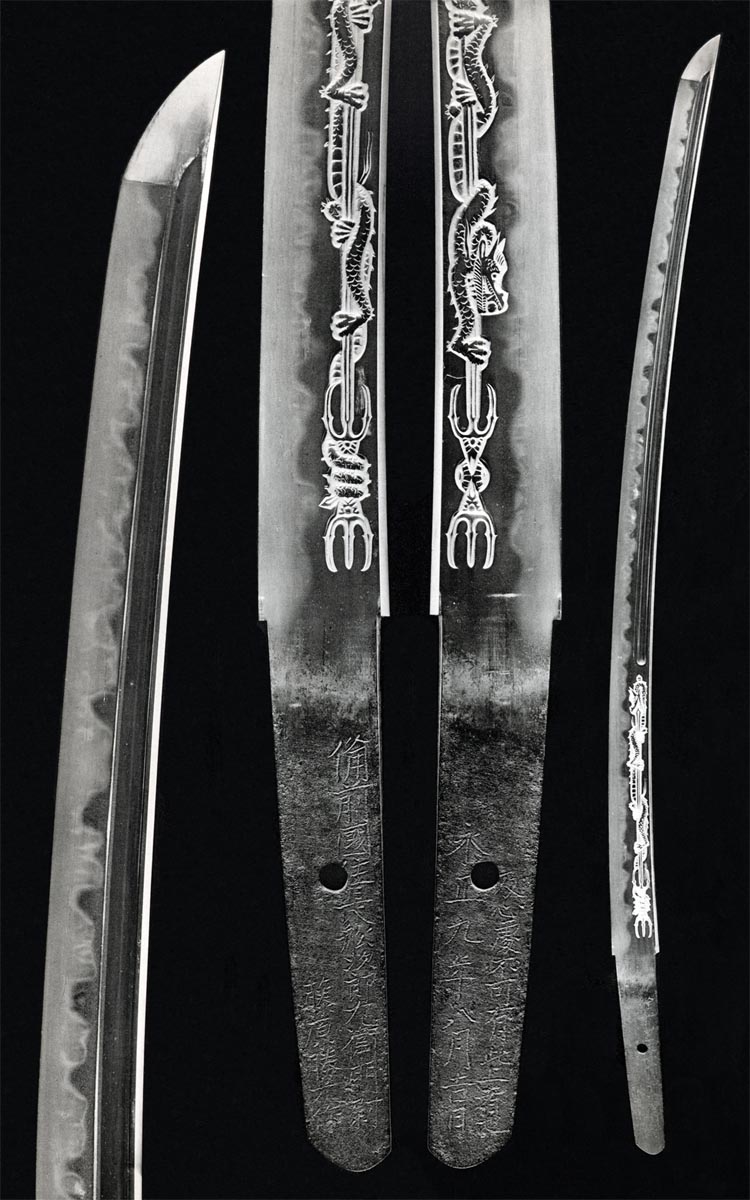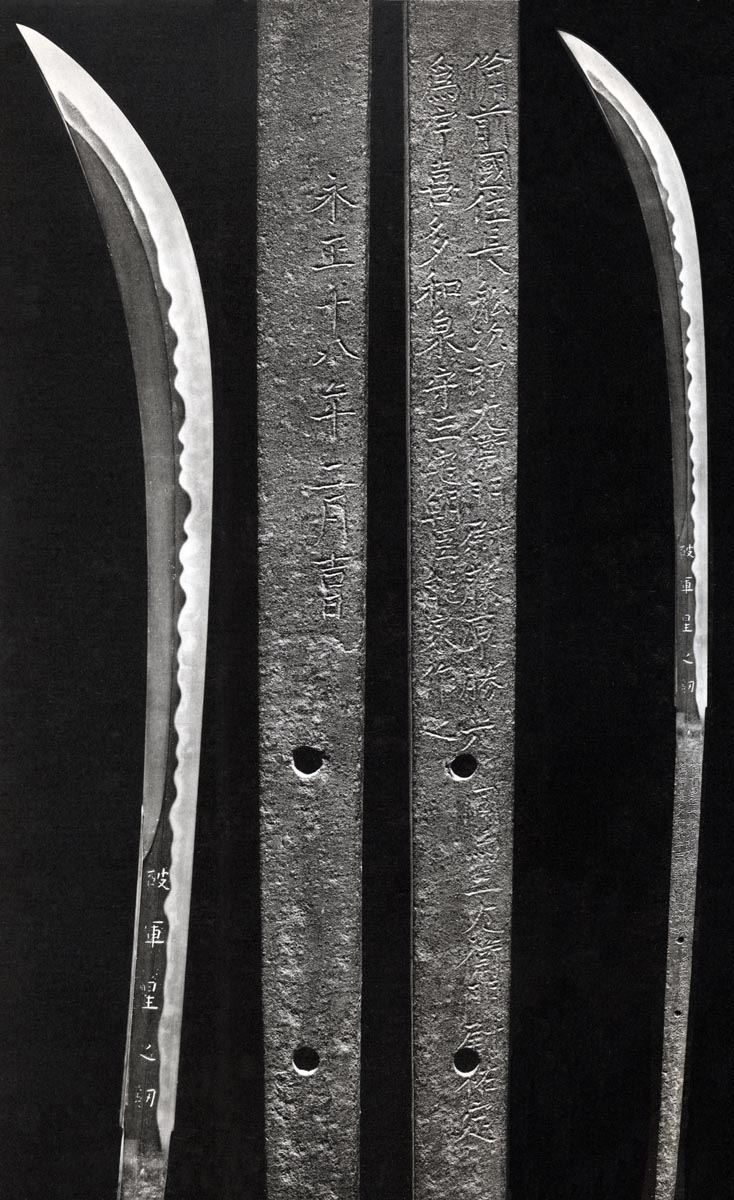ROKUROZAEMON SUKEMITSU(1) KA-KICHI (f: TOSHIMITSU): The father of
SAKYOnoSHIN MUNEMITSU and UKYOnoSUKE KATSUMITSU, he might
be considered the father of SUE-BIZEN. Although noted as
the third of his name from NAMBOKUCHO times, he falls
from the TOSHIMITSU/SANEMITSU OSAFUNE line. See OEI BIZEN
TOSHIMITSU. Work between EI-KYO 1429 and KAN-SHO 1460.
His TACHI SUGATA has the grace of the OEI. Long OEI style
O-TANTO might be found. MOKUME HADA with standing UTSURI
and NIOI GUNOME-CHOJI BA are his KANSHO BIZEN mark.
Note: YAKI-KUZURE turns OEI KOSHI-HIRAKI valleys toward
the SUE-BIZEN "Crab-claw" styles fruited by his famous
sons, MUNEMITSU and KATSUMITSU. See following
BISHU OSAFUNE SUKEMITSU
BISHU OSAFUNE JU ROKUROZAEMONnoJO SUKEMITSU
ROKUROZAEMON SUKEMITSU(2) BUN-MEI: Work from O-NIN 1467 into the
BUN-MEI. MOKUME HADA. GUNOME-CHOJI BA.
BISHU OSAFUNE ROKUROZAEMONnoJO SUKEMITSU
Sue-Bizen Katsumitsu - Munemitsu
SAKYOnoSHIN MUNEMITSU BUN-MEI (f: SUKEMITSU, br: KATSUMITSU): The
5th MUNEMITSU from NAGAMITSUs' SHO-WA 1312 KO-OSAFUNE
School. Like OEI MORIMITSU, he is the star of his time,
being teacher and way-path for many. This family
literally brought their SUE-BIZEN style to new places,
such as neighbors, HARIMA and MIMASAKA and faraway OMI,
displacing an old and long held sway. The SENGOKU
received the MURAMASA, HEIANJO, SHIMADA group impact
along with MUNEMITSU's SUE-BIZEN. MINO postured its
product against these successes.
SENGOKU Influences MINO
KANESADA/KANEMOTO
SOSHU TSUNAHIRO
with HIROMASA
MUNEMITSU/KATSUMITSU and FUSAMUNE
and the SUE-BIZEN
The BUN-GI Triad
SENGO MURAMASA
BUNGO TAIRA NAGAMORI HEIANJO NAGAYOSHI
SHIMADA YOSHISUKE
MUNEMITSU was the second son of ROKUROZAEMON SUKEMITSU
and a date of EI-KYO 9, or 1437 is given for his birth.
He was the younger brother of UKYOnoSUKE KATSUMITSU and
uncle to UKYOnoSUKEs' son, the heralded JIROZAEMON. These
were the heavy hitters of the SUE-BIZEN. An accepted
OSHIGATA dating from TAI-EI shows his to be one of the
longest sword careers, spanning BUN-MEI through KYO-ROKU
1528. An always noted note: there are many collaboration
pieces with brother, UKYOnoSUKE. Following his brother's
death, MUNEMITSU found nephew, JIROZAEMON KATSUMITSU for
partnerships. Pieces with JIROZAEMON inscriptions should
be presumed past MEI-O 9, 1500. SAKYOnoSHIN was a teacher
of sword making to MIMASAKA JOSHU Lord AKAMATSU MASANORI,
the reclaimer of HIMEJI Castle. UKYOnoSUKE KATSUMITSU,
SAKYOnoSHIN student, MIMASAKA MUNEMITSU and others
followed MASANORI on ASHIKAGA YOSHIHISAs' SEIBATSU to
OMI. See MIMASAKA, HARIMA and OMI. MUNEMITSU made strong,
wide KOSHIZORI UCHIGATANA with little FUNBARI. There may
be BO-HI. He holds a reputation for short, BIZEN-style
NAKAGO on DAITO, but long NAKAGO on his strong and thick
UCHIZORI TANTO. Standing KO-MOKUME shows JI-NIE and an
excellent near-UTSURI of NIE JI-BA, a BIZEN old and
special mark. His dynamic and wide-standing GUNOME-CHOJI
set the ideal for the SUE-BIZEN. It was here the famous
KANInoTSUME "Crab-claw" CHOJI began.
BIZEN-no-KUNI JU OSAFUNE SAKYOnoSHIN MUNEMITSU
BIZEN-no-KUNI YUKIE-GORI JU OSAFUNE SAKYOnoSHIN MUNEMITSU
BIZEN-no-KUNI OSAFUNE SUKEMITSU JINAN SAKYOnoSHIN MUNEMITSU SAKU
BIZEN-no-KUNI OSAFUNE KATSUMITSU MUNEMITSU
BITCHU OITE KUSAKABE SAKU
SUE-BIZEN KATSUMITSU - MUNEMITSU
MIMASAKA MUNEMITSU CHO-KYO: IWATA ROKUROZAEMON. TSUKATANI JU in
MIMASAKA. This is a brother student with the famous
AKAMATSU MASANORI, Lord of HARIMA, who was the second
coming for the AKAMATSU in HARIMA (see MASANORI below).
SAKUSHU MUNEMITSU studied with SAKYOnoSHIN and then lived
at MIMASAKA. He and other of his BIZEN alma mater went
with MASANORI to OMI for ASHIKAGA YOSHIHISAs' SEIBATSU
siege of the ROKKAKU. Work from BUN-MEI 1469 to EI-SHO
1504. GUNOME-MIDARE BA with ASHI-IRI in the SAKYOnoSHIN
style. HA-AGARI KURI-JIRI NAKAGO with slight curve.
Characters are wide set, thin but firmly put.
See MIMASAKA
SAKUSHU JU MUNEMITSU
SAKUSHU TSUKATANI JU ROKUROZAEMONnoJO MUNEMITSU
MASANORI CHO-KYO (t: SAKYOnoSHIN MUNEMITSU): AKAMATSU JOSHU "Lord
of the HARIMA AKAMATSU," nephew of AKAMATSU MITSUSUKE.
KATANA, TANTO and WAKIZASHI in HARIMA and MIMASAKA. His
work is in the style of SAKYOnoSHIN: KO-MOKUME with
JI-NIE. NIOI KO-MIDARE, KO-GUNOME CHOJI BA with ASHI.
GUNOME-TOGARI theme. Pattern may seem to thin out in the
lower. MIDARE BOSHI with FUKASHI-KAERI. See HARIMA for
examples and the story of the AKAMATSU, MIMASAKA and OMI
HYOBU SHOYU MINAMOTO ASON MASANORI SAKU
JUSHI-I SAKYO-DAYU MINAMOTO ASON MASANORI SAKU
|
